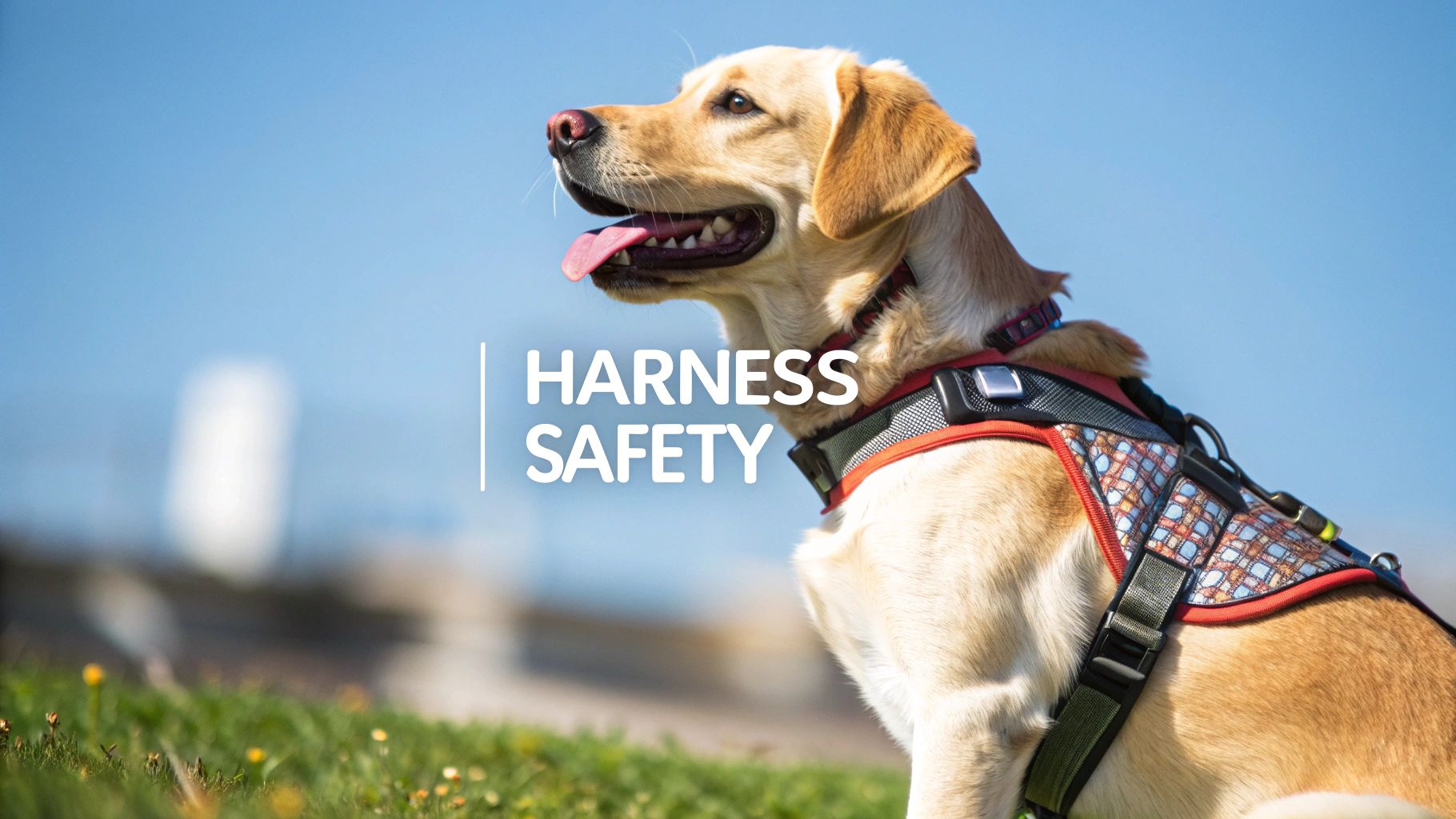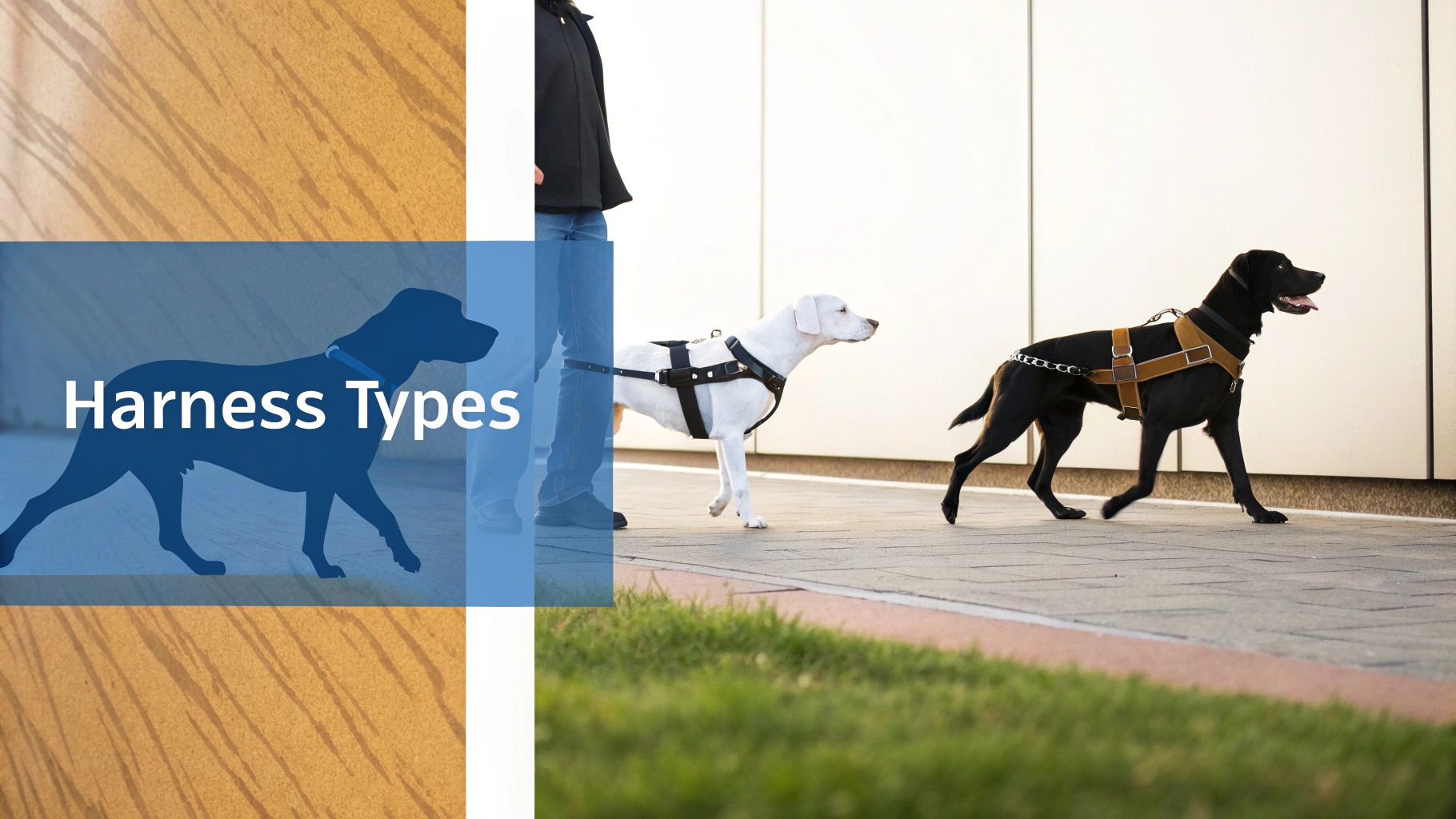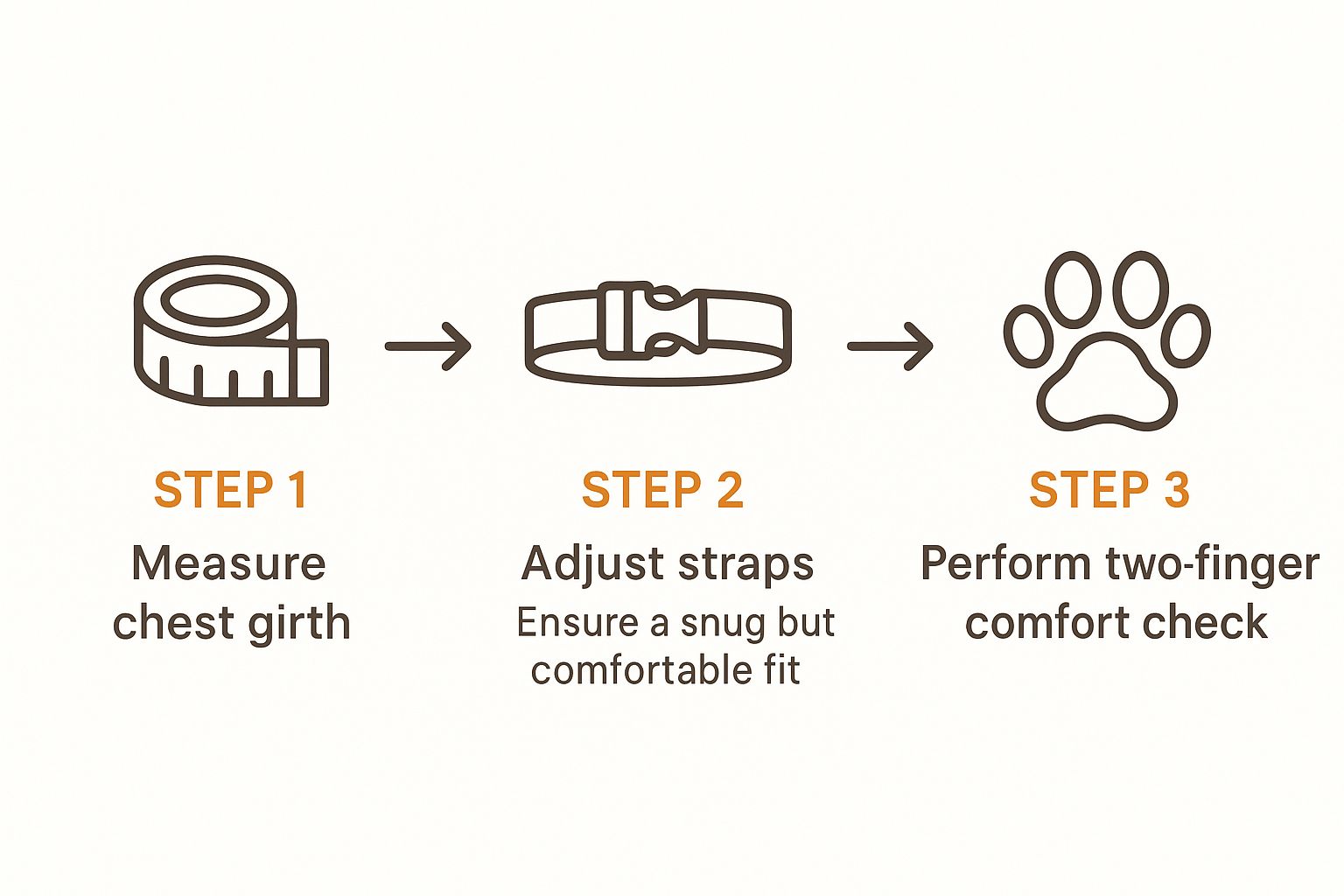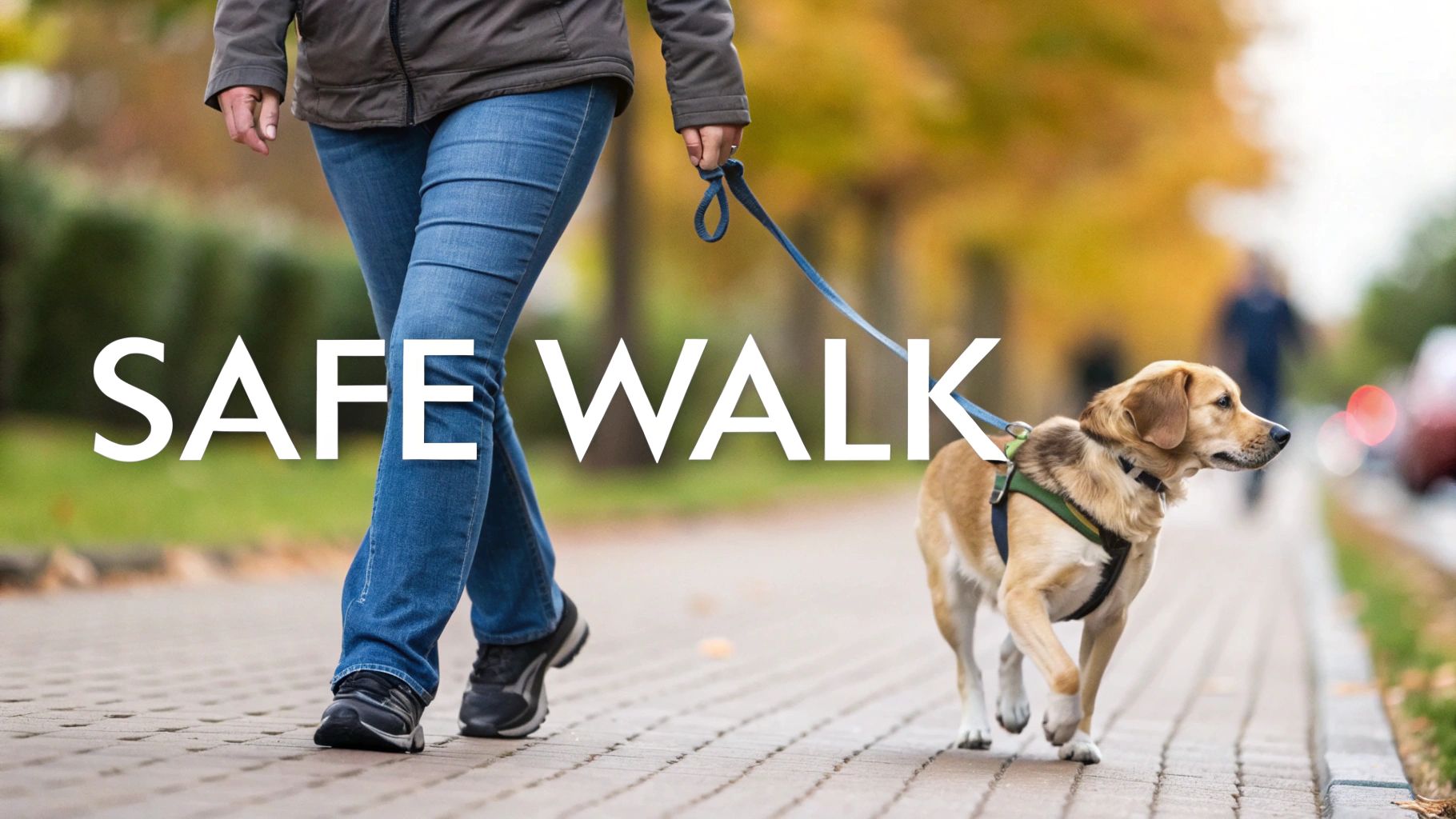Proper dog harness safety starts with one simple idea: a harness spreads out pulling force across your dog's chest and shoulders, keeping pressure off their sensitive neck. This is the fundamental reason it's a safer, more comfortable choice than a traditional collar, especially if your dog is a puller or has a delicate throat.
Why Harness Safety Is a Game Changer for Your Dog

Picture this: your dog makes a sudden lunge for a squirrel. If they’re wearing a collar, all that force snaps directly onto their throat. Ouch. This can cause some pretty serious problems, like tracheal collapse, neck strain, or even damage to their thyroid gland.
The risk is even higher for brachycephalic (flat-faced) breeds like Pugs and French Bulldogs. Their respiratory systems are already a bit compromised, so any extra pressure on the neck is a big no-no.
A well-fitted harness, on the other hand, works more like a safety belt. It takes that pulling force and distributes it across the strongest parts of your dog’s body—their chest and back. This not only prevents injury but also gives you way better control without choking or causing them pain.
The Benefits of Switching to a Harness
The move toward harnesses isn't just a fad; it's a real shift in how we think about our pets' well-being. This trend is so significant that the global dog harness market was valued at USD 2.74 billion in 2023. It's expected to jump to a staggering USD 7.05 billion by 2031—a clear sign that owners are prioritizing pet safety.
Here’s a quick rundown of the advantages:
- Injury Prevention: It dramatically cuts the risk of neck, throat, and spinal injuries.
- Better Control: Many designs, especially front-clip harnesses, gently redirect your dog’s momentum to discourage pulling.
- Escape-Proof Security: A snug harness is much tougher for a dog to slip out of than a collar. Houdini-dogs, I'm looking at you.
- Travel Safety: They're absolutely essential for securing your dog in a vehicle.
The core idea is simple: a harness works with your dog’s body, not against it. This makes walks, hikes, and travel less stressful and far safer for everyone involved.
Harness vs Collar A Quick Safety Comparison
Here's a quick look at the primary safety and control differences between a standard collar and a well-fitted harness. This can help you see why so many of us have made the switch.
| Feature | Dog Harness | Traditional Collar |
|---|---|---|
| Pressure Point | Distributes force across the chest and shoulders. | Concentrates all force directly on the neck and throat. |
| Injury Risk | Low risk of neck, throat, or spinal injuries. | High risk of tracheal collapse and other neck injuries. |
| Control | Offers superior control, especially with front-clip models. | Provides limited control for dogs that pull heavily. |
| Security | Highly secure; very difficult for a dog to slip out of. | Can be easily slipped over the head if not fitted tight. |
| Comfort | Generally more comfortable, allowing natural movement. | Can be uncomfortable and cause choking if the dog pulls. |
| Best For | Pullers, small breeds, brachycephalic breeds, and travel. | Dogs that are well-trained on a loose leash. |
Ultimately, for most situations—especially travel—a harness just makes more sense from a safety perspective.
When it comes to travel, a harness is non-negotiable. Whether you're heading out on a long drive or just making a quick trip to the vet, it's the foundation for keeping your companion secure. For more great ideas, check out our guide on how to make a road trip with your dog successful.
How to Choose the Right Harness for Your Dog
 Choosing the right harness is your first real step toward better dog harness safety, but walking into a pet store can feel overwhelming. The walls are lined with options, and it's easy to get lost in a sea of straps and clips.
Choosing the right harness is your first real step toward better dog harness safety, but walking into a pet store can feel overwhelming. The walls are lined with options, and it's easy to get lost in a sea of straps and clips.
The trick is to zero in on what your dog actually needs. Think about their walking style, their energy level, and what you'll be doing together. Your goal is simple: find a harness that gives you control while keeping your pup comfortable and safe.
Most harnesses boil down to a few key designs, and the main difference is where you clip the leash. Getting this one detail right can change everything about your walks.
Leash Attachment Styles Explained
Where that little metal D-ring is located completely changes how the harness works. Each style has its own purpose, tailored for different dogs and different situations.
-
Front-Clip Harnesses: You'll often hear these called "no-pull" harnesses, and for good reason. The leash attaches right at the center of your dog's chest. When they try to pull ahead, it gently pivots them back toward you. It's a game-changer for training dogs that lunge or drag you down the street, giving you way more control without any yanking or choking.
-
Back-Clip Harnesses: This is your classic, go-to style. The leash clips onto a ring on your dog's back, making it a fantastic choice for dogs who are already polite walkers. It keeps the leash from getting tangled in their legs, which is perfect for a casual hike or a jog in the park.
-
Dual-Clip Harnesses: Can't decide? You don't have to. These harnesses give you the best of both worlds, with clips on both the front and the back. Use the front clip when you're working on leash manners and switch to the back clip for those relaxed, sniff-filled strolls. It's maximum versatility in a single piece of gear.
There's a persistent myth that harnesses actually encourage pulling. Let's clear that up: a harness is a safety tool, not a magic training fix. A dog pulls for a bunch of reasons—pure excitement, a squirrel that needs chasing—and a good harness simply protects their neck from injury while you work on the behavior.
The surge in no-pull designs isn't just a trend; it's a huge shift toward safer, kinder training methods. The market for no-pull harnesses hit roughly USD 1.4 billion in 2023 and is expected to more than double by 2033. This isn't just about business; it shows a real-deal awareness among owners about the damage traditional collars can do. You can dig into the numbers and see the full market forecast to learn more.
Material and Activity Considerations
Once you've picked a clip style, it's time to think about your dog's lifestyle. The harness you need for a quick potty break is totally different from the one you'd pack for a weekend in the mountains.
For everyday walks, a lightweight mesh harness is often a perfect fit. It’s breathable, so your dog won’t get too hot, and it’s comfortable enough for just hanging out.
But if you two are the adventurous types, you’ll need something tougher. Look for harnesses made from durable, weather-resistant nylon with padding on the straps to prevent rubbing and chafing on long hikes. Many of these adventure harnesses also have a handle on the back—trust me, it’s incredibly helpful for giving your dog a boost over logs or rocks.
Finally, don't overlook the little safety details. Reflective stitching is non-negotiable for us. It adds a critical layer of visibility for those early morning or late evening walks when you're near traffic.
Getting the Perfect Fit on Your Dog's Harness
A harness that doesn't fit right isn't just uncomfortable for your dog; it completely undermines its purpose. If it’s too loose, you’re looking at an escape waiting to happen. Too tight, and you risk painful chafing, restricted movement, and even nasty skin irritation. Nailing that perfect, secure fit is hands-down the most important step after you've picked out the right style.
The good news? You don't need to be a pro to get this right. It all starts with one simple measurement.
Before you even think about adding a harness to your cart, grab a soft measuring tape. Wrap it around the widest part of your dog's chest, just behind their front legs. That single number—the chest girth—is the key to finding the correct size.
This process is really a three-part dance: measure, adjust, and check.

As you can see, it flows from getting an accurate measurement to making careful adjustments, and then finishing with that critical hands-on check for both comfort and security.
Adjusting for a Snug and Secure Feel
Once you have the harness, it’s time to dial in the fit. Most quality harnesses give you multiple adjustment points, usually around the neck and chest area. My advice is to loosen all the straps before you even try to put it on your dog for the first time.
Next, gently slip it on, secure the buckles, and start tightening each strap evenly. You want the harness to sit snugly against their body, but not dig in. The goal is to close up any big gaps where a paw could get tangled or your dog could Houdini their way out. Just make sure it isn't pinching them or messing with their natural stride.
The Two-Finger Rule and Final Checks
The best way to test your work is the classic “two-finger rule.” You should be able to slide two fingers comfortably between the harness and your dog's body at any point. Can't fit them in? It's definitely too tight. If you can easily slide your whole hand in, it’s dangerously loose and needs to be tightened immediately.
A properly fitted harness should stay centered on your dog's back and chest. It shouldn't twist, sag, or shift all over the place when they walk. If you notice any of that happening, it’s time to go back and readjust the straps.
Finally, keep an eye out for any red flags during and after your first few walks:
- Chafing or Red Marks: Always check under your dog’s front legs and around their chest for any signs of angry, irritated skin.
- Restricted Movement: Is their stride looking a bit awkward or shorter than usual? The harness might be interfering with their shoulder movement.
- Fur Loss: Finding patches of missing fur under the straps is a dead giveaway that the harness is rubbing way too much.
Taking these few extra minutes to get the fit just right is what transforms a simple piece of gear into an essential tool for keeping them safe.
Mastering Car Travel with a Safety Harness

Let's talk about something that's easy to overlook but critically important: an unrestrained dog in a car. It’s not just a distraction—it's a massive safety risk for everyone. In a sudden stop, an 80-pound dog can fly forward with 2,400 pounds of force. That's a staggering number, and it’s why a proper car safety harness isn't just a nice-to-have, it's a non-negotiable.
It's tempting to just clip your dog’s everyday walking harness to the seatbelt and call it a day. I get it. But this is a common—and dangerous—misunderstanding. A walking harness is designed for leash pressure, not for the violent forces of a car crash.
Crash-Tested Harnesses Are a Different Breed
A true car safety harness is engineered from the ground up for one purpose: keeping your dog secure in a moving vehicle. These harnesses go through intense crash testing to prove they can withstand extreme impacts without failing.
Using a walking harness in a car gives you a false sense of security. It's like using a piece of string as a seatbelt.
So, what makes a car-specific harness so different?
- Built to Last: They're made with heavy-duty webbing and solid steel hardware that won't buckle under pressure.
- Smart Connections: The design ensures the tether attaches to the strongest points of the harness, distributing force safely across your dog's chest.
- Proven Performance: Reputable brands are proud of their crash-test certifications and will share that information. If you can't find it, that's a red flag.
A huge mistake I see people make is using a standard leash as a car tether. A leash is built to have some stretch and give, which means it will almost certainly snap in an accident, offering virtually no protection. You must use a dedicated seat belt tether.
The tether is just as crucial as the harness itself. You need one that connects the harness directly to your car’s seat belt buckle or LATCH anchor system. For dogs who are big-time chewers, something like a chew-proof heavy-duty seatbelt for pets offers that extra peace of mind.
When you're getting your dog buckled in, pay close attention to the tether's length. The sweet spot is short enough to keep them from hitting the front seat or flying out a window, but just long enough for them to comfortably sit, stand, and lie down. Nailing proper dog harness safety is all about creating that perfect balance of security and comfort for every trip you take together.
Essential Gear to Boost Harness Safety
Getting a great harness is a fantastic first step, but it's only half the equation. To create a truly reliable safety system, you have to pair it with the right leash. A flimsy or worn-out leash completely undermines the security of even the best harness, creating a weak link right where you need strength the most.
Think of your leash as the critical lifeline between you and your dog. Choosing a high-quality one isn't an upgrade—it's an essential part of your dog's travel gear and a core component of dog harness safety.
What to Look For in a Leash
When you're picking out a leash, durability and security should be your top priorities. A good leash does more than just connect you to your dog; it gives you peace of mind on crowded city streets and remote hiking trails alike.
Here's what I always look for:
- Tough Materials: If you've got a chewer, look for leashes made from chew-resistant nylon or even coated steel wire.
- Secure Hardware: A locking carabiner clip is a game-changer. It offers a much more secure connection to the harness D-ring than a standard bolt snap, preventing those heart-stopping accidental unclips.
- High Visibility: For those early morning or late evening walks, reflective stitching or integrated LED lights are non-negotiable. They make you and your pup visible to traffic and can prevent a serious accident.
A top-notch leash and harness combination is your dog's seatbelt for the world. It ensures the control and safety features you invested in are never compromised by a weak connection.
This growing demand for better safety gear is making waves in the pet industry. In fact, the dog safety leash market is on track to hit USD 5.8 billion by 2025, largely driven by owners like us who want features like ergonomic handles, GPS, and lighting. You can read more about this expanding pet safety market to see where things are headed.
For a perfect example of a leash that ticks all these boxes, take a look at our premium bungee dog leash for large breeds. It's built with exactly these kinds of critical safety elements in mind.
Got Questions About Harness Safety? Let's Talk.
Even with the perfect harness picked out, a few questions always pop up when it comes to day-to-day use. That's totally normal. Getting these details right is what keeps your dog safe and comfortable on every outing. Let's clear up some of the most common ones I hear from fellow dog owners.
Can My Dog Just Wear Their Harness 24/7?
I get why people ask this—it seems convenient! But honestly, harnesses are best for walks and travel, not for lounging around the house.
Leaving a harness on all the time can cause some real problems, like painful skin irritation and chafing under the straps. For dogs with thicker coats, it can even lead to matted fur. It's much better to take it off once you're back home so their skin and coat can breathe. Think of it like taking off your running shoes after a workout—it just feels better.
How Can I Be Sure the Harness Fits Just Right?
This is a big one. A poor fit isn't just uncomfortable; it's a safety risk. The easiest way to check is with the good old "two-finger rule." You should be able to slide two fingers snugly between any part of the harness and your dog's body.
- Is it too tight? If you can't get two fingers under there, it's definitely too restrictive.
- Is it too loose? If you can easily fit your whole hand, it's an escape waiting to happen. Cinch it down.
Pay attention on your walks, too. If the harness is twisting to the side or shifting all over the place, it's a sign that it's too loose and needs adjusting.
One of the first signs of a bad fit is chafing, especially in the sensitive area under their front legs (their "armpits"). Make a habit of checking this spot for any redness after you get back from a walk. It's a dead giveaway that you need to readjust the straps.
Which Is Safer: A Front-Clip or Back-Clip Harness?
There’s no single "safer" option here—it really comes down to your dog and what you're trying to accomplish. They’re just different tools for different jobs.
A front-clip harness, often called a "no-pull" harness, is fantastic for training. When your dog pulls, the clip on the chest gently redirects their momentum, turning them back toward you. It’s a great way to teach better leash manners without any harsh corrections.
A back-clip harness is perfect for dogs who are already polite walkers or for activities like hiking where a front leash might get tangled in their legs. For the best of both worlds, some harnesses come with both a front and a back clip, giving you total flexibility.
At Pet Voyages, we know that the right gear makes all the difference. We believe every trip with your best friend should be safe, comfortable, and full of great memories. Explore our collection of hand-picked travel essentials and get ready for your next adventure.

